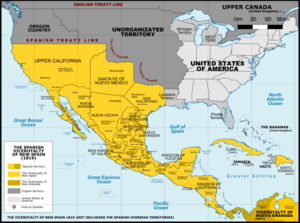Nueva Vizcaya, New Spain
| New Biscay Nueva Vizcaya |
|||||
| Type of subdivision of (the) Former Country | |||||
|
|||||
|
Coat of arms |
|||||
| New Spain (1819) | |||||
| Capital | Victoria de Durango | ||||
| Government | Viceroyalty | ||||
| Governor-General | |||||
| • | 1562 | Francisco de Ibarra | |||
| History | |||||
| • | Established | 1562 | |||
| • | Mexican Independence | September 27, 1821 | |||
Coat of arms
Nueva Vizcaya (New Biscay) was the first province in the north of New Spain to be explored and settled by the Spanish. It consisted mostly of the area which is today the states of Chihuahua and Durango in Mexico.
Spanish exploration of the area began in 1531 with Nuño Beltrán de Guzmán's expedition. He named the main city he founded Villa de Guadalajara after his birthplace and the area he conquered "Conquista del Espíritu Santo de la Mayor España" ("Conquest of the Holy Spirit of Greater Spain"). The Spanish regent Queen Joanna replaced this with Nuevo Reino de Galicia ("New Kingdom of Galicia").
Especially under the leadership of Francisco de Ibarra, settlements moved north into the interior of the continent after silver was discovered around Zacatecas. Ibarra named the new area Nueva Vizcaya after his homeland in Spain, Biscay. Nueva Vizcaya included the modern Mexican states of Chihuahua and Durango, the eastern parts of Sonora y Sinaloa and the southwest part of Coahuila. The region was under the jurisdiction of the Royal Audience of Guadalajara and the administration of its president.
...
Wikipedia


